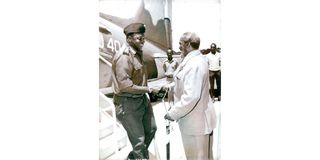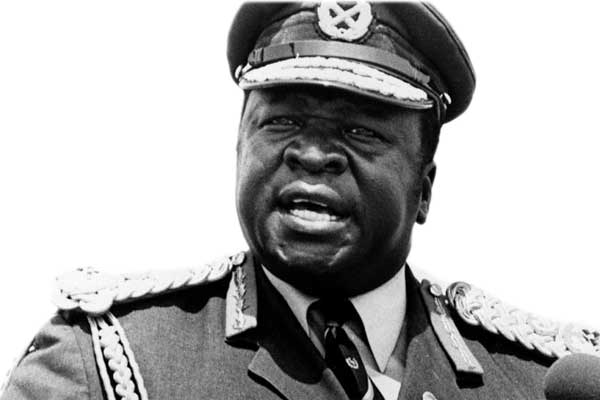When Kenya almost went into war with Uganda’s Idi Amin over a missing girl

Uganda’s President Idi Amin (left) meets President Jomo Kenyatta at the airport in Mombasa in 1970s.
Entebbe Airport, February 13, 1976: Two Kenyan girls from Makerere University are heading home as Idi Amin’s reign of terror on Kenyans reaches new heights.
Esther Chesire, a second-year law student, is 22 and so is her friend, Sally Githere. With their air tickets, some luggage and passports, the two girls go through the immigration protocols and are waiting to board the East African Airways flight EC629 to Nairobi. The girl-talk, perhaps animated, was quickly broken when officers from Uganda’s State Research Bureau, Idi Amin’s terror squad, approached them and demanded to see their passports.
“Follow us,” the girls were told by the mean characters. The officers seemed to have interest in Ms Chesire, who came from a prominent family that was close to Jomo Kenyatta’s vice-president Daniel arap Moi. “Are you sure you are a student at Makerere?” The officer prodded Ms Chesire. It was a period when being framed as a spy was a capital offence. “We are going to find out,” the officer said, according to the Washington Post. As Ms Githere, who was present during the questioning, would recount later, they were asked to sign some papers. She was then put on the Nairobi bound plane while her roommate was left behind.
Ms Chesire, perhaps not realising the danger, told her friend that she would catch the next evening flight. She didn’t and – despite threats of war – she has never been found.
Business dealings
The Washington Post reported that her brother, Reuben Chesire – then chairman of Kenya Farmers Association and Kenya Tourist Development Corporation, had business dealings with Amin. But Reuben denied the paper’s claim saying he had “absolutely no business contact with Uganda” and that his sister did not know Amin.
The tale of Ms Chesire is the story of a populace that cheered the rise of a tin-god and how a nation, once applauded as the Pearl of Africa, descended into zealot levels. Though ex-President Milton Obote was hated and had terrorised Ugandans before he was deposed, the Kampala populace cheered on Idi Amin as he established institutions of terror. The first was the State Research Bureau – the outfit blamed for Ms Chesire’s disappearance.
During the Obote rule, this outfit was known as the General Service Unit and was notorious for silencing critics. Then, after the 1971 coup, Idi Amin, with the help of Israelis, dissolved the GSU and formed a new military intelligence agency through a presidential decree. It was named State Research Centre and, despite its misleading name, it was supposed to collect and sieve intelligence from its Nakasero Hill headquarters. The other notorious outfit was Public Safety Unit, an instrument of spying and repression also financed by Israel, which was building a new armoury for Idi Amin.

Esther Chesire as a 22-year-old university student when she disappeared.
The relationship between Amin and the Israelis was deep. It is now known that on the morning of the January 25, 1971, when Obote was deposed, the British High Commissioner to Uganda, Richard Slater, had found Amin working under the guidance of Israeli’s Col Bar-Lev, a Mossad operative in the region. Actually, Amin’s first trip abroad was to Israel where he met with Prime Minister Golda Meir.
That State Research Centre became the State Research Bureau after Amin fell out with Israelis over a row about sale of fighter jets to Uganda. From then, State Research Bureau was transformed into a terror squad – a gang of murderers and extortionists. Nobody, apart from Idi Amin, was beyond their reach. And when they walked to the two Kenyan girls, everybody was worried about their fate.
State Research Bureau had its regional equivalents. Kenya had the dreaded Special Branch, led by James Kanyotu, which operated various ‘safe houses’ and some mini torture chambers. The best known locations were Kingsway House, during the Kenyatta era, before Nyati House and Nyayo House became bastions of terror. Ethiopia’s Mengistu Haile Mariam had his own Central Investigation Organ, which had its own network of prisons and courts, while Somali’s Siad Barre had his Defence Security Agency, locally known as Hangash, and whose powers overlapped those of National Security Service (NSS).
While several Kenyans had disappeared in Uganda, including the June 1974 disappearance of freedom fighter Kungu Karumba, that of Ms Chesire triggered more diplomatic uproar. It also coincided with Idi Amin’s territorial claim on Kenya.
“No other issue has bothered this office like this one. Why they are keeping her there is not known. It is very unkind to her parents,” said Dr Munyua Waiyaki, Kenya’s Foreign Minister who was pursuing the matter.
Until late March, 1976, the Uganda government had insisted that Ms Chesire was safe in custody and that investigations were still going on. Initially, the “soldier-boys” – as Dr Waiyaki used to call them – had told him that the girl “was happy and was being questioned.”
But when Kenya went public about Miss Chesire’s disappearance, the Uganda military spokesman sent a statement to Radio Uganda and attacked Kenya for “disclosing” that Miss Chesire had been arrested and detained. The statement asked the Kenyatta government to “keep quiet and concentrate on their own problems…they should refrain from involving the Uganda government (whose) record is clean, especially on human rights.”
The bulletin further warned Kenya against making “unfounded allegations” saying: “We are tired of unfounded political rallies in Kenya against Uganda. We are not cowards (and are) not interested in replying to malicious and unfounded charges. The Uganda government has no knowledge of any girl who is alleged to have disappeared from the university.”
It was a lie. The military spokesman then hoped to shift the blame: “The spokesman wishes to clarify that the girl in question and the other Kenyan students have been going to Kenya regularly without the consent of the university.” It was at this point that President Amin set up a commission of inquiry led by Brian Langlands, a British-born professor of geography at Makerere University, to investigate Ms Chesire’s disappearance alongside her classmate Paul Sserwanga.
Dr Waiyaki had hoped he would handle the issue at the diplomatic level. But Kampala played rough diplomatic games and refused to respond to Dr Waiyaki’s letters as stipulated in international diplomatic policy. The commission of inquiry was Idi Amin’s trick to buy time. But Dr Waiyaki did not relent. He continued to put pressure on Uganda government as Kenya announced the closure of its border.
“It is the soldier-boys now speaking and they are telling us to mind our own business,” a frustrated Waiyaki told the media in Nairobi.
Hope was that the Langlands’ commission might unravel the truth about Miss Chesire’s disappearance. One of the witnesses to the inquiry was mathematics professor, Mrs Nanziri Mukasa-Bukenya, the Warden of Africa Hall, a women’s residence hall at Makerere. As she prepared to appear before the Langlands’ Commission, some officers from the State Research Bureau knocked on her door. They demanded that her testimony should paint Ms Chesire as a person of immoral character who must have fell victim of one of her jilted lovers. An incorruptible character, Mrs Mukasa-Bukenya refused to provide false testimony. A day before she testified, on June 23, 1976, she was abducted by unknown people and her lifeless body later found floating in Ssezibizwa River with her hands still tied behind her back. She had a gunshot wound on her head.
Three days later, on July 26, Brian Langlands, the chairman of the commission, was expelled from Uganda and thus did not get to the bottom of Ms Chesire’s disappearance. A new submissive chairman was appointed and on November 12, the inquiry concluded that Ms Chesire had left for Kenya and that “if university rules had been followed, no-one would have been shot.” It was a contradictory report. It did not inquire into the death of Mrs Mukasa-Bukenya.
As the crisis between Kenya and Uganda continued, another Kenyan student was beaten up and ended up at Mulago Hospital and later at the university sick-bay before being discharged. This was my good friend, Nation columnist Magesha Ngwiri, then a second-year literature student. Magesha owes us a story. Perhaps – a book on Idi Amin and Makerere.
Most of the Kenyan students who suffered under Idi Amin were part of University of Nairobi exchange programme, which allowed them to study in Uganda. Amin was, by then, the Chancellor of Makerere University and amidst this crisis, he would be awarded an honorary doctorate degree whose citation read: “Field Marshal Amin has restored law and order, contained armed robbery and made Ugandans live their lives free of fear.” It was a lie. On the Makerere University website, the university says Amin “conferred upon himself the Doctorate of Law of Makerere University.”
The confrontation between Kenya and Uganda not only heightened the tension between the two countries –but also tells us the folly of having a dictator and a criminal in power.
Idi Amin was a lesson to Africa – and Ms Chesire’s disappearance remains one of the painful memories of a young innocent girl, caught in the eye of regional politics and dictatorship.
*Authored by John Kamau
[email protected] @johnkamau1




